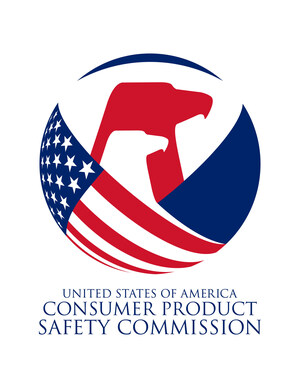WASHINGTON , May 23, 2017 /PRNewswire-USNewswire/ -- https://www.cpsc.gov/Newsroom/News-Releases/2017/New-CPSC-Report-Fatal-Drownings-in-Pools-Involving-Young-Children-Decreases-By-17-Percent-Nationwide-Since-2010
A new report released today by the U.S. Consumer Product Safety Commission (CPSC) shows that the number of reported fatal child drownings in swimming pools involving children younger than 5—the most vulnerable population—has decreased 17 percent nationwide since 2010, the year our Pool Safely public education campaign was launched. Despite the decrease, fatal and non-fatal child drownings in pools and spas continue to pose a public health challenge across the United States. In national and local media interviews today, CPSC Acting Chairman Ann Marie Buerkle urged families to be vigilant when children are in and around the water this summer.
"Despite the positive decline in numbers, there are still far too many children who drown each year in pools and spas across the country," said Acting Chairman Buerkle. "Swimming should be fun and a great way for families to be active, so long as everyone knows how to pool safely. As a mother, grandmother and registered nurse, I raised my kids, and now my grandkids, with a respect for water. Constant supervision, along with four-sided fencing, knowing how to perform CPR and teaching children how to swim are all important steps to continuing the decline in child drownings."
CPSC's latest data shows there were 346 reported fatal child drownings in pools and spas in 2014 involving children younger than 15, compared to 397 reported fatal drownings in 2010—a 13 percent decrease. Of the 346 reported fatal child drownings in 2014, 252 involved children younger than 5. This is a 17 percent decline when compared to 302 fatal drownings involving children younger than 5 in 2010. Other key findings include:
- Between 2012 and 2014, the majority (77 percent) of reported fatal drowning victims younger than 15 were younger than 5 of which two-thirds (66 percent) were male.
- For children younger than 15 years old, more than two-thirds (68 percent) of the reported fatal drowning victims were boys.
- For 2014 through 2016, an estimated average of 5,900 children younger than 15 years old were reported as being treated in hospital emergency rooms for non-fatal drowning injuries in pools or spas.
- Between 2014 and 2016, the majority (74 percent) of children treated in emergency departments for pool- or spa-related, non-fatal drowning injuries were younger than 5 years of age.
- Between 2014 and 2016, residential locations made up 86 percent of fatal reported incidents and at least 55 percent of non-fatal reported drowning incidents for children younger than 5.
Note: CPSC's report addresses non-fatal drownings for the period from 2014 through 2016 and fatal drownings for the period from 2012 through 2014, reflecting a lag in the reporting of fatal drowning statistics.
In addition, today CPSC also released an updated report on suction entrapment incidents in swimming pools, spas and whirlpool bathtubs. Key findings include:
- From 2012 through 2016, there were 17 victims of entrapment in 16 incidents, with 82 percent of the incidents involving children younger than 15 years of age (14 victims).
- From those 16 incidents, there were two fatalities, both in residential spas.
- Since the Virginia Graeme Baker Pool & Spa Safety went into effect in Dec. 2008, there have been no drain entrapment-related deaths involving children in public pools and spas.
The complete report can be found at PoolSafely.gov.
"Memorial Day weekend represents the traditional start of the summer swim season," said Acting Chairman Buerkle. "Before heading to the pool this weekend, I ask all parents and kids to join me and the more than 50,000 others—including Olympians Katie Ledecky and Michael Phelps—and take Pool Safely Pledge."
Parents and caregivers are reminded to follow Pool Safely's simple steps to keep children safer in and around the water:
- Install a four-sided fence with a self-closing, self-latching gate around all pools and spas.
- Designate a Water Watcher to supervise children at all times around the water. This person should not be reading, texting, using a smart phone or be otherwise distracted.
- Learn how to swim and teach your child how to swim.
- Learn how to perform CPR on children and adults.
- Keep children away from pool drains, pipes and other openings to avoid entrapments.
- Ensure any pool and spa you use has drain covers that comply with federal safety standards and if you do not know, ask your pool service provider about safe drain covers.
Pool Safely, a national public education campaign supporting the requirements of Section 1407 of the Virginia Graeme Baker Pool and Spa Safety Act, works with partners around the country to reduce child drownings, non-fatal drownings and entrapment incidents in swimming pools and spas. Parents, caregivers, and the media are encouraged to visit: PoolSafely.gov or @PoolSafely on Twitter for vital safety information regarding the prevention of child drownings in and around pools and spas.
The U.S. Consumer Product Safety Commission is charged with protecting the public from unreasonable risks of injury or death associated with the use of thousands of types of consumer products under the agency's jurisdiction. Deaths, injuries, and property damage from consumer product incidents cost the nation more than $1 trillion annually.
CPSC Consumer Information Hotline
Contact us at this toll-free number if you have questions about a recall:
800-638-2772 (TTY 301-595-7054)
Times: 8 a.m. – 5:30 p.m. ET; Messages can be left anytime
Call to get product safety and other agency information and to report unsafe products.
Media Contact
Please use the phone numbers below for all media requests.
Phone: 301-504-7908
Spanish: 301-504-7800
SOURCE U.S. Consumer Product Safety Commission
Related Links
WANT YOUR COMPANY'S NEWS FEATURED ON PRNEWSWIRE.COM?
Newsrooms &
Influencers
Digital Media
Outlets
Journalists
Opted In





Share this article